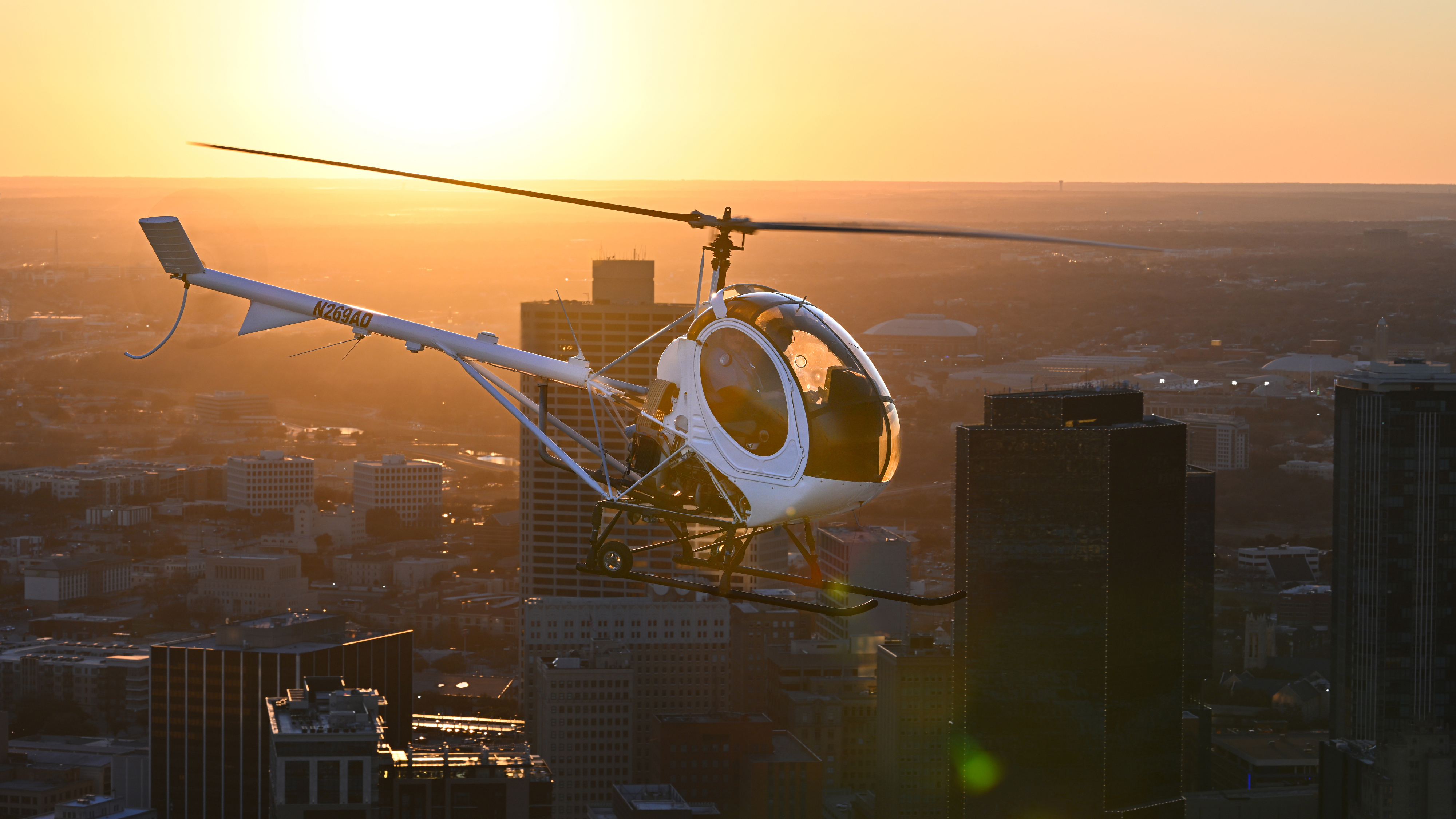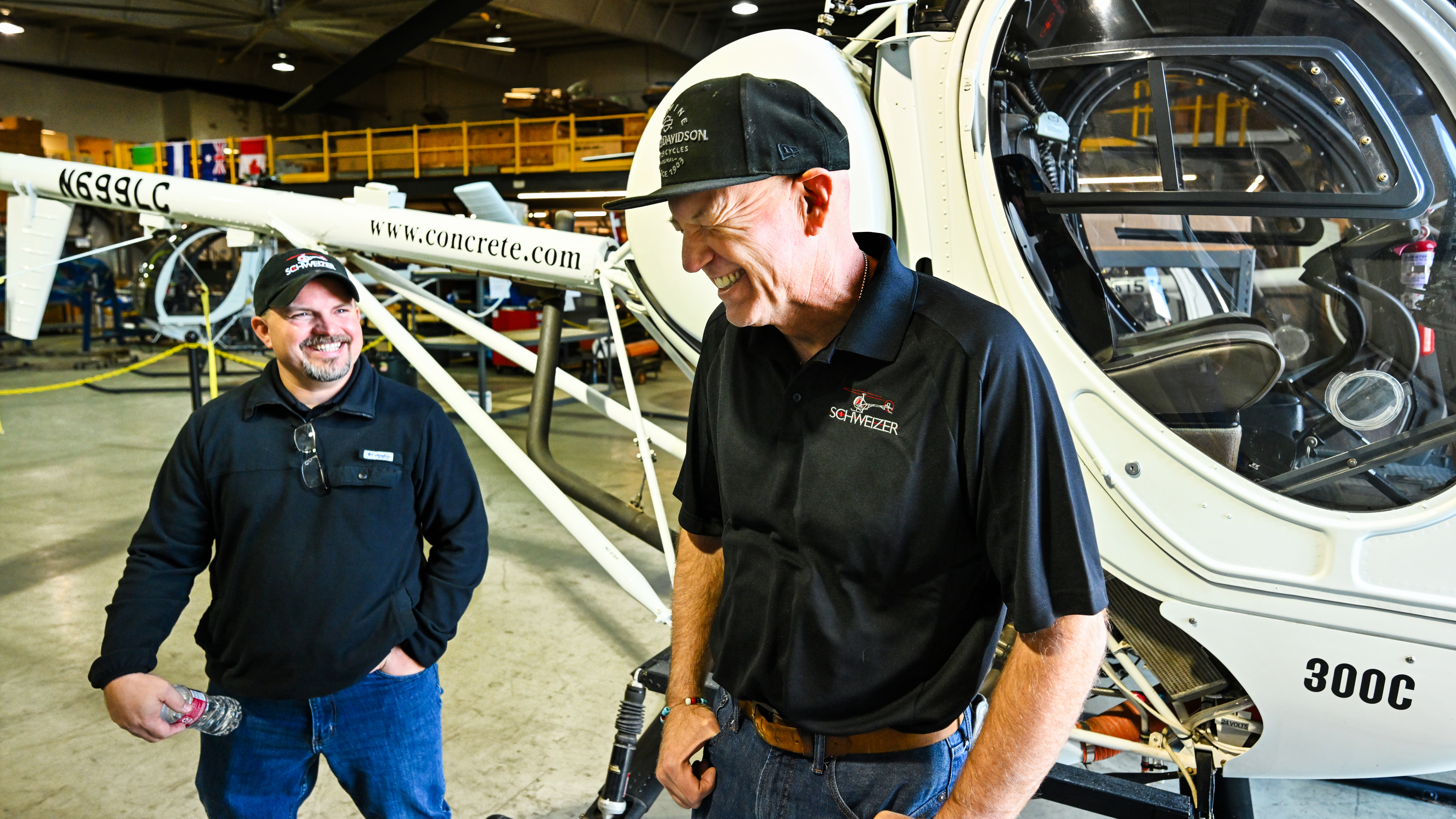Schweizer is back
A popular trainer returns to the helicopter market
By Murray Huling
There is something about revisiting an old friend, one you spent many hours with years ago, learning their nuances, intricacies, and what makes them tick. This was the feeling I had as I climbed into the familiar cockpit and took the pilot in command’s right seat in Schweizer’s most recently manufactured S300CBi.

Trainer for generations
As I pulled pitch on that long-ago warm South Texas winter afternoon in December 2000 with my then-14-year-old daughter aboard for her first helicopter ride, I was confident she would enjoy it. She was my first passenger just days after I became a helicopter pilot, and my trusty steed for the flight was the venerable Hughes 300C—with the doors off to top it off. After probably the most thorough preflight I have ever done, my confidence was immediately rewarded as we lifted off; she had the biggest smile and a laugh that continued throughout the hour-long flight around the beautiful Texas countryside.
Like me, thousands of pilots have learned to fly helicopters in a version of the Hughes, which is now known as the S300CBi. The S300CBi has a revered history dating back to the late 1950s. The aircraft division of the Hughes Tool Company developed the Hughes 269A as a low-cost two-seater that was rugged yet simple and easy to maintain. The 269A was eventually picked up by the U.S. Army as its primary helicopter training platform, as the TH–55 Osage. With nearly 1,000 deliveries and serving until retirement in 1988, when the U.S. Army went to turbine training helicopters, the TH–55 was used to train an estimated 60,000 U.S. Army helicopter pilots how to fly. The helicopter had evolved into the 269C and 269C–1, with the C model being the most powerful version with 190 horsepower and the C–1 having 180 horsepower.
Ownership of the type certificate has changed over the years. Hughes sold the type certificates to Schweizer in Elmira, New York, and after a few years, Sikorsky purchased them. Sikorsky stopped producing S300C and S300CBis in 2011, then restarted to build 16 more, then stopped production again. Schweizer RSG, a new company led by a previous Schweizer executive, purchased the 269C, 269C–1, and the S333 model type certificates from Sikorsky in 2018 and is now known as Schweizer.
Since beginning production of new helicopters in 2021 Schweizer has delivered 12 new aircraft and is projecting to do 12 to 15 per year in the short term and ramp up to double that as demand increases. A key FAA fuel tank approval in 2024 allows the manufacturer to deliver aircraft domestically, reentering the market where Hughes found such a foothold.


Back in action
When Schweizer first obtained the type certificates many owners had parked their aircraft away in a hangar to pull parts to keep others flying. Schweizer needed to be able to build parts in addition to building up their spares and parts supplies. Schweizer President and CEO David Horton and his team first focused on getting parts and components produced and delivered before starting up the production line for new aircraft. Schweizer estimates there are around 1,500 used 300s around the world that need support. In 2021, the company received its production certificate to build new aircraft after getting the supply chain and parts availability back in action.
The factory is housed in a large hangar at Meacham International Airport (FTW) in Fort Worth, Texas. As a retired FAA maintenance safety inspector, I noticed the cleanliness and organization in the new production and the repair station sections. The repair station is where used aircraft are factory refurbished to like-new condition, and others are inspected and repaired for current customers. Although both are in the same hangar, distinct barriers and markings separate the two areas, which is a regulatory requirement. On the wall for all personnel to see was a monitor that showed the status of all aircraft at work, another great feature showing full transparency. The stores and parts areas were secured in a large, caged section of the hangar. Schweizer has done well in fixing the supply chain.
Having worked on 300s for years as an A&P, seeing the various stages of the building process and the repair station performing maintenance and refurbishment, I was able to reminisce how much I enjoyed working on them but knew I needed to fly one as well.
schweizer s300cbI



Flying the new S300CBi
With its extensive, proven training history, the S300CBi brings a lineage well-known as “one of the safest piston engine helicopters in the world,” according to Horton. One of the big draws to Schweizer 300s is the standard helicopter cyclic and collective controls, allowing students to start training from the beginning in the same control systems they will fly as they move through their career into larger helicopters.
The S300CBi I was flying was sponsored by its new owner, U.S. Aviation Training Solutions Inc. (USATS), in Titusville, Florida, a flight training school with 20 new Schweizer helicopters on order with an option for five more for their fleet modernization.
Having completed all my private pilot helicopter training in the 300B and C models, I have always appreciated how well-designed and well-respected the helicopter is, and this flight certainly validated the qualities I remember most about the machine. Qualities like stability, roominess, good useful load, plenty of power, agility, ease of maintenance access and what many consider the best reason to fly them: regular collective and cyclic dual helicopter controls.
My safety pilot for the flight was Michal Birdsell, a 20-year veteran of the helicopter industry with more than 7,000 hours in helicopters and an impressive résumé flying agriculture, seismic, powerline/pipeline, sightseeing , photography, survey, and Part 135 passenger and cargo operations before joining Schweizer in 2021. Birdsell is responsible for tech support, the Part 145 repair station, and conducting all new aircraft production test flights.
Many who have flown the variations of the 300 will distinctly remember rotor engagement requiring the joggling of the engage switch and finessing the engine rpm with the twist grip throttle in the left hand to ensure it doesn’t shutdown or overspeed. Things are a little simpler now on the new Schweizer 300s because of the automatic engagement system (AES). The AES/startup rpm limiter/low rotor warning control unit provides protection previously unavailable for 300s. Once the AES switch is engaged the throttle doesn’t need any adjustment as the eight rotor belts tighten and bring the rotors up to speed.
After Birdsell repositioned the helicopter and brought it to a hover, he gave me the controls and had me do a couple of 360-degree turns to get the feel back. Then I took off from the ramp, and we headed southbound to do some off-airport maneuvering. I was surprised how familiar it felt as it seemed like it took no time to get the “feel” back.
Once out of the airport’s towered airspace, we flew some off-airport approaches to a beautiful, large pasture that also serves as the test flight area for the new production test flights.

What’s next?
Schweizer is optimistic about the future. Beginning in 2021, Schweizer has been delivering new 300s through the Foreign Military Sales program to Senegal and El Salvador as trainers for each of their militaries. A crash-resistant fuel cell requirement for all helicopters manufactured after April 5, 2020, kept Schweizer from delivering new helicopters domestically until the company could get its crash-resistant fuel cells approved by the FAA, which it attained in 2024. New S300Cs start around $620,000 and S300CBis start around $550,000 before options. Refurbished 300Cs, if using their airframe, will run around $425,000 and a 300CBi will run around $400,000 before options. Noteworthy is that refurbished helicopters come with the same new aircraft factory warranty and are designed to provide a helicopter that can fly for 2,000 to 2,200 hours with only normal maintenance other than the 1,500-hour TBO on the 300C’s engine. The best thing about Schweizer helicopters is there is no mandatory overhaul of the airframe, although like the majority of helicopters, there are some limits on some component overhaul times such as for the main transmission and tail rotor gearbox along with life limits on the blades and tail boom.
Horton shared that the company is considering future upgrades to the S300CBi, including updated engines and avionics. Schweizer also continues to approve new Schweizer service centers to help ensure support for their helicopters is available domestically and internationally.
We all know how expensive insurance is in aviation, especially helicopter insurance, and Schweizer has worked on helping reduce this cost by working with its insurance provider, Arthur J. Gallagher, to come up with insurance policy options dedicated to anyone operating Schweizer 300C and CBI models based on their safety record.
Birdsell shared that Schweizer’s refurbishment program is thorough and active. We viewed a 1980 S300C at the end of its refurbishment, and it looked just like it came off the showroom floor…which it did. And it was soon to be on its way to its owner.
Schweizer’s turbine helicopter is the S333, which continues to be supported. The plan is that when there is a launch customer for new S-333s, Schweizer will start up the production line to fill that need as well. In today’s dollars, Horton estimates the S333 turbine would start at $1.8 million.

My takeaway
I left Schweizer’s factory and my favorite training helicopter with a renewed positive outlook on the company’s future based on what I witnessed and heard from Horton, Birdsell, and the team. We have all seen OEMs go through owner and leadership changes, as that is nothing new in aviation. But how a company rebounds makes the difference, and from what I witnessed, they have gone about it smartly by working on fixing parts availability first then beginning producing and delivering new 300s, along with adding upgrades to this storied helicopter that has trained thousands of pilots since the first came off the line in 1959. 
Murray Huling is AOPA’s vice president of regulatory affairs. He is a private pilot single-engine land with instrument, rotorcraft-helicopter, and airframe and powerplant ratings.


